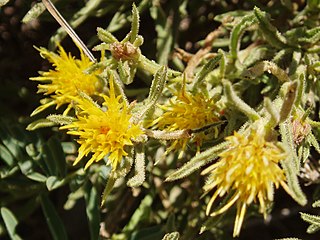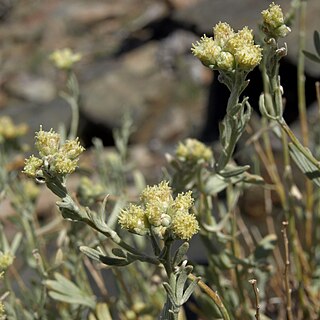
Chrysothamnus, known as rabbitbrush, rabbitbush, and chamisa, are a genus of shrubs in the family Asteraceae. The native distribution is in the arid western United States, Canada, and northern Mexico. It is known for its bright white or yellow flowers in late summer.

Ericameria is a genus of North American shrubs in the family Asteraceae.

Ericameria nauseosa, commonly known as chamisa, rubber rabbitbrush, and gray rabbitbrush, is a shrub in the sunflower family (Aster) found in the arid regions of western North America.

Ericameria bloomeri, known by the common names Bloomer's rabbitbush and Bloomer's goldenbush, is a species of flowering shrub in the family Asteraceae. This plant is native to the mountains of western North America from British Columbia to California, including Washington, Oregon, Idaho, and Nevada. It may have been extirpated from Canada.

Ericameria cuneata is a species of flowering shrub in the family Asteraceae known by the common name cliff goldenbush. This plant is native to the southwestern United States and northwestern Mexico.

Ericameria discoidea, commonly known as whitestem goldenbush or sharp-scale goldenweed is a species of flowering shrub in the family Asteraceae. This plant is native to the western United States from California, Oregon, Nevada, Utah, Colorado, Idaho, and Montana.

Brickellia californica, known by the common name California brickellbush, is a species of flowering plant in the family Asteraceae.

Chrysothamnus viscidiflorus is a species of shrub in the family Asteraceae of the Americas known by the common names yellow rabbitbrush and green rabbitbrush.
Ericameria fasciculata is a rare species of flowering shrub in the family Asteraceae known by the common name Eastwood's goldenbush. It is endemic to northern California, where it is known from fewer than twenty locations. Many sources described it as found only in Monterey County, but the Calflora database maintained by the University of California reports additional collections from nearby Santa Cruz and Santa Clara Counties. These collections are, however, from inhabited regions and might represent either introductions or cultivated specimens.

Ericameria greenei is a species of flowering shrub in the family Asteraceae known by the common name Greene's goldenbush. It is native to the mountains of the western United States in Washington, Idaho, Oregon, and the northern California as far south as Lake and Tuolumne Counties.
Phalacroseris is a monotypic genus of flowering plants in the family Asteraceae containing the single species Phalacroseris bolanderi, which is known by the common name Bolander's mock dandelion.

Pyrrocoma carthamoides is a species of flowering plant in the family Asteraceae known by the common name largeflower goldenweed. It is native to western North America from British Columbia to northeastern California to Wyoming, where it is known from grassland, woodlands, forests, barren areas, and other habitat. It is a perennial herb growing from a taproot and producing one or more stems to about half a meter in maximum length, the stems reddish-green and leafy. The largest leaves are at the base of the stem, measuring up to 20 centimeters long, lance-shaped with spiny sawtoothed edges. Leaves higher on the stem are smaller and hairier. The inflorescence is a single flower head or a cluster of up to four. Each bell-shaped head is lined with phyllaries each up to 2 centimeters long. It has many yellow disc florets surrounded by a fringe of yellow ray florets up to 7 millimeters long; ray florets are occasionally absent. The fruit is an achene which may be well over a centimeter in length including its pappus.

Rudbeckia californica is a species of flowering plant in the family Asteraceae, known by the common name California coneflower.

Sphaeromeria cana is a species of flowering plant in the family Asteraceae known by the common name gray chickensage. It is native to the western United States, where it is known from the Sierra Nevada, the adjacent desert ranges of eastern California and Nevada, and Steens Mountain of Oregon. It grows in dry, rocky mountain habitat, such as cracks and crevices, including the talus above the tree line. This is an aromatic subshrub with numerous erect branches growing up to 30 to 60 centimeters tall. It is gray-green in color and coated with woolly fibers. The leaves are linear or lance-shaped, the lower ones divided into lobes. The inflorescence is generally a cluster of flower heads lined with woolly phyllaries and containing yellow disc florets. There are no ray florets. The fruit is a ribbed achene about 2 millimeters long.

Townsendia condensata is a species of flowering plant in the family Asteraceae known by the common names cushion Townsend daisy and cushion townsendia. It is native to North America where it is known from many scattered occurrences in the mountains of the western United States and Alberta in Canada. It is mainly limited to the alpine climates of high mountain peaks, where it grows in meadows, tundra, and barren, rocky talus. It grows alongside other alpine plants such as Eriogonum androsaceum.
Ericameria gilmanii is a rare North American species of flowering plants in the family Asteraceae known by the common names Gilman's ericameria, Gilman's goldenbush, Gilman goldenweed, and whiteflower goldenbush. It is endemic to California, where it has been found in and east of the southern Sierra Nevada, in Inyo County and on Owens Peak in northeastern Kern County. It is a poorly known plant. There are six known populations, but only one has been observed in the last 20 years.

Ericameria paniculata is a species of flowering plant in the sunflower family Asteraceae, native to the southwestern United States. It is an evergreen yellow-flowered desert shrub.
Chrysothamnus molestus is a species of flowering plant in the family Asteraceae known by the common names Arizona rabbitbrush, Tusayan rabbitbrush, disturbed rabbitbrush, and stickyfruit low rabbitbrush. It is endemic to the State of Arizona in the southwestern United States, where it is known from Coconino, Apache, and Navajo Counties.
Chrysothamnus humilis, called Truckee rabbitbrush, is a North American species of flowering plants in the tribe Astereae within the family Asteraceae. It has been found in northern California, Oregon, Washington, northern Nevada, southwestern Idaho.

Ericameria parishii, or Parish's rabbitbrush, is a western North American species of flowering plants in the family Asteraceae.














